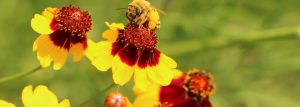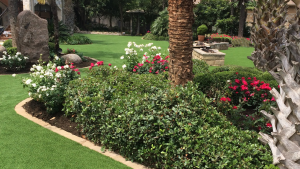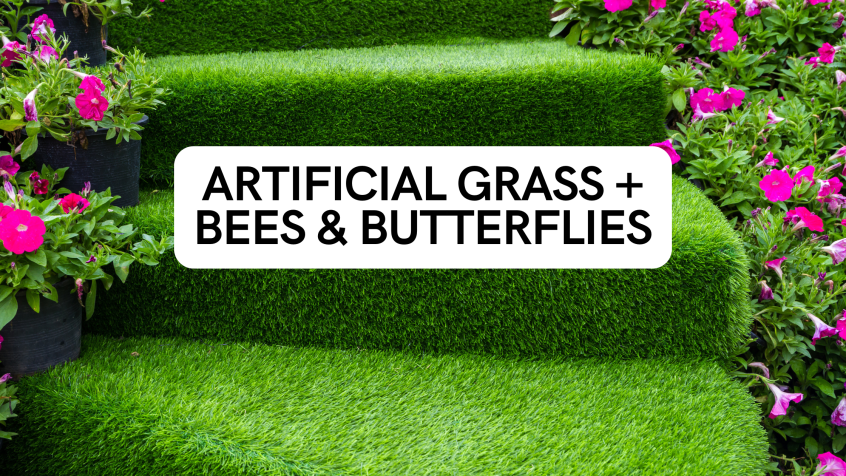Artificial grass is often celebrated for its low maintenance, water conservation benefits, and year-round beauty. But as more homeowners and businesses make the switch to synthetic turf, a common eco-concern arises: What about pollinators? Bees, butterflies, and other beneficial insects rely on natural landscapes for food and habitat. Does installing artificial grass mean giving up on supporting them?
The good news: you can enjoy the benefits of artificial grass while still creating a pollinator-friendly environment. It just requires thoughtful design.
In this article, we explore how to balance the convenience of artificial turf with backyard biodiversity, best practices for pollinator-friendly landscaping, and expert tips from eco-conscious landscapers.
The Balance Between Low-Maintenance Turf and Biodiversity
Artificial grass provides:
- No watering — saving thousands of gallons annually.
- No pesticides or herbicides — reducing harmful chemicals in the ecosystem.
- Year-round greenery — keeping spaces visually appealing.
However, turf alone doesn’t provide nectar, pollen, or shelter for pollinators. The key is integrating natural plant zones around your artificial lawn to maintain biodiversity.
Best Practices for Pollinator-Friendly Landscaping with Artificial Grass
1. Plant Borders and Edges with Native Flowers
Borders along your artificial grass can be planted with native, nectar-rich flowers. Native plants require less maintenance and attract local pollinators more effectively than non-native species.
Popular options:
- Milkweed (for monarch butterflies)
- Lavender
- Coneflowers
- Bee balm
See a list of native plant suggestions from the Xerces Society
2. Add Wildflower Strips
Set aside a section of your yard for wildflowers. Even a small strip can become a thriving pollinator hotspot.
Tips:
- Use seed mixes designed for your climate.
- Avoid mowing during bloom season.
- Plant in sunny areas for maximum pollinator activity.

3. Create Green Corridors
Pollinators need continuous access to food sources. By linking garden beds, planters, and wildflower patches around your artificial grass, you create a network of resources.
Integration ideas:
- Install planters along walkways.
- Use raised beds around patios.
- Place potted herbs like basil, mint, and thyme near seating areas.
How to Integrate Turf Seamlessly into Eco-Conscious Landscape Designs
A pollinator-friendly landscape with artificial grass should:
- Incorporate color variety to attract a diverse range of species.
- Provide shelter through shrubs, small trees, and climbing plants.
- Include water sources such as shallow birdbaths or bee-friendly puddling areas.
Design tip: Surround your turf with layered planting zones — short wildflowers in front, taller perennials behind — to create depth and habitat.
Expert Insights: Eco-Landscaper Tips
We spoke with eco-landscapers who specialize in blending artificial grass with pollinator habitats.
Tip from Sara M., Sustainable Landscape Designer: “Your artificial grass can be the functional core for play or entertaining, but by framing it with pollinator gardens, you create a biodiverse backyard that still meets your maintenance goals.”
Tip from Michael R., Native Plant Specialist: “Think vertically. Climbing vines on trellises and flowering shrubs add nectar sources without taking up lawn space.”
Tip from Janice L., Urban Ecologist: “Even small yards can make a big difference. A single milkweed plant can support dozens of monarch caterpillars.”

Why Supporting Pollinators Matters
Pollinators are critical to:
- Food production — 1 in 3 bites of food comes from pollinated plants.
- Biodiversity — they help maintain healthy ecosystems.
- Climate resilience — diverse plant life supports soil health and water retention.
Unfortunately, pollinator populations are declining due to habitat loss, pesticides, and climate change. Designing your artificial grass landscape with pollinators in mind is one way to reverse that trend.
Final Thoughts
Artificial grass doesn’t have to mean a pollinator-free yard. By incorporating native flowers, wildflower strips, and connected plant corridors into your design, you can support bees, butterflies, and other beneficial species while enjoying the convenience of a lush, low-maintenance lawn.
When planned thoughtfully, artificial grass can be part of an eco-conscious landscape that’s both beautiful and biodiverse.
Ready to design a pollinator-friendly artificial grass yard? Explore Smart Turf’s turf options and combine them with sustainable planting practices to create a yard that benefits you and the environment.

